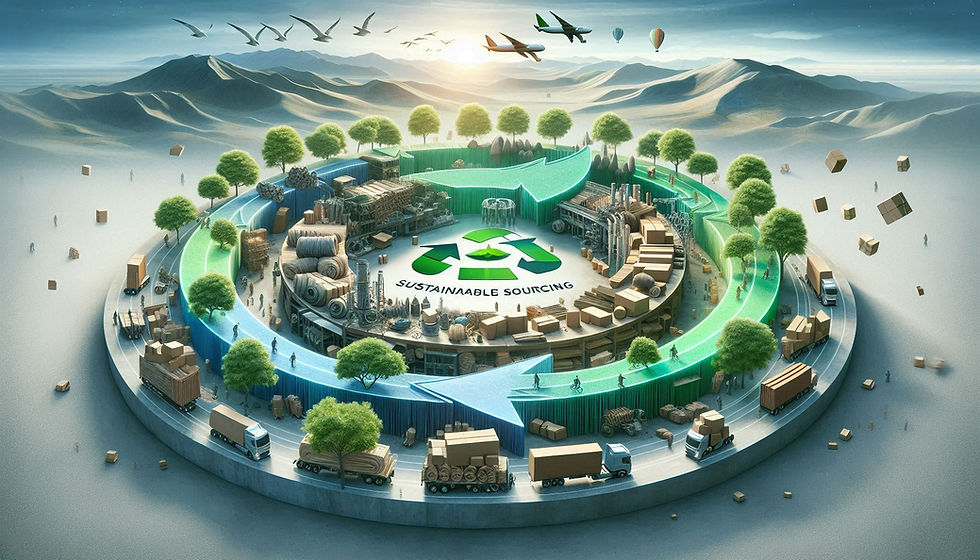5 Innovative Circular Economy Solutions: Transforming Waste Management for Businesses
- Aaron Levin
- Jan 4
- 4 min read
The concept of a circular economy is becoming crucial for companies aiming to reduce their environmental impact. Unlike the traditional linear model of "take, make, dispose," the circular economy takes a comprehensive approach to waste management.

By focusing on sustainability, businesses can turn waste into resources, creating value while protecting the planet. This blog post explores the core principles of a circular economy, highlights leading companies implementing these ideas, and offers actionable tips for businesses eager to embrace this more innovative approach.
Understanding Circular Economy Principles
At its essence, the circular economy emphasizes resource efficiency and sustainability. It aims to extend the lifecycle of materials, minimizing waste and pollution. Some key principles include:
Design for Longevity: Focus on creating products that are durable, repairable, and upgradable, thereby extending their useful life. For example, a well-designed appliance can last 10 to 15 years, reducing the frequency of replacements.
Resource Recovery: Develop systems for recovering and repurposing waste materials rather than sending them to landfills. For instance, in 2020, the recycling rate for plastics was only around 9%, highlighting the need for better recovery systems.
Systems Thinking: Consider how operations affect the environment and community. For instance, using locally sourced materials can reduce transportation emissions.
Engagement with Consumers: Mobilizing consumer awareness can significantly promote demand for sustainable products. 66% of consumers are willing to pay more for sustainable brands.
Collaborative Innovation: Collaboration among businesses, governments, and consumers is key to developing innovative solutions that promote circularity.
Case Study 1: Unilever's Sustainable Packaging Initiative
Unilever stands out for its commitment to sustainability in packaging. The company pledges to make all its plastic packaging recyclable, reusable, or compostable by 2025. This ambitious goal is supported by new designs that utilize sustainable materials.

To further engage customers, Unilever has launched refill stations in various markets. These stations allow customers to refill containers instead of buying new ones, reducing new plastic demand and encouraging consumers to change their consumption habits.
Case Study 2: Chevrolet’s Electric Vehicle Battery Recycling
Chevrolet has developed a circular approach to address the challenge of disposed electric vehicle batteries. The company repurposes these batteries for energy storage systems, providing backup power for homes and businesses.

This innovative strategy extends battery life and helps mitigate energy shortages. Chevrolet is advancing a more sustainable automotive model by focusing on lifespan extension and resource recovery.
Case Study 3: Patagonia’s Repair & Reuse Programs
Patagonia is a leader sustainably. The company encourages customers to repair rather than discard clothing. Their Worn Wear program allows customers to buy, sell, or trade used gear.

By emphasizing quality and durability, Patagonia supports the principle of designing for longevity. This initiative reduces waste while creating a community centered on sustainability, which strengthens customer loyalty.
Practical Tips for Businesses Transitioning to a Circular Economy Model
Transitioning to a circular economy model is more than a strategic shift; it requires a deep commitment to sustainability. Here are helpful tips to guide this journey:
1. Assess Current Practices
Start by thoroughly evaluating waste management practices. Identify gaps and opportunities for improvement. Understanding material flows can lead to targeted circular initiatives.
2. Engage Employees and Stakeholders
Get employees involved in the transition. Raise awareness about the value of a circular economy and encourage innovative ideas. Collaborate with stakeholders for insights that enhance efforts.
3. Redesign Products and Services
Focus on creating products with longevity and recyclability in mind. Consider modular designs that are easy to repair. Using sustainable materials that can be reused contributes to circularity.
4. Implement Take-Back Programs
Establish return programs to encourage customers to recycle used products. Offering incentives for returning items can lead to significant reductions in waste.
5. Measure and Report Progress
Set clear goals and key performance indicators for circular initiatives. Publicly sharing results demonstrates a commitment to sustainability, which can improve brand reputation.

6. Foster Innovation through Collaboration
Partner with other businesses, non-profits, and academic institutions to spark innovative ideas. Joint efforts can lead to new technologies and materials that support circular practices.
7. Educate and Inspire Customers
Use marketing strategies to share the benefits of circular practices. Educational campaigns can help consumers understand the importance of sustainability in their choices.
A Path Forward
Transitioning to a circular economy is more than a passing trend; it is a substantial shift in how businesses approach sustainability and waste. Companies like Unilever, Chevrolet, and Patagonia demonstrate the impact of pioneering practices that actively reduce waste.
By integrating circular economy principles and actionable strategies, businesses can decrease their environmental impact while boosting brand loyalty and market position. Though the journey to a circular economy presents challenges, today's innovative solutions make it achievable.
Embracing this model fosters a sustainable, equitable future. As businesses recognize the importance of resource efficiency and collaboration, they can help shape a circular economy that benefits society and the planet.



Comments